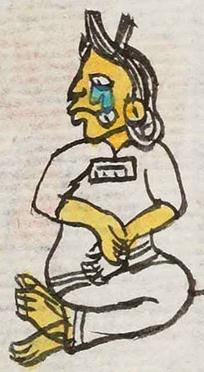Cahuallan (Mdz13v)
This is a simplex glyph to the extent that the widow (cahualli) stands in for the full town name (Cahualan or Cahuallan), and the -tlan locative suffix is not visual. The woman sits with her knees folded under her and with her knees pointed to the viewer's right. Her head is also in profile, facing to the viewer's left. The rest of her body faces frontally toward the viewer. This result is a kind of contortion. Her hands come together in front of her body. Her huipilli (blouse) and cueitl (skirt) are both white, but the huipil has a rectangle over her chest. Her skin tone is a tan color. She has turquoise blue tear drops coming from the one eye the viewer can see.
Stephanie Wood
The tears have a semantic value, suggesting that this is not just a woman but a widow or abandoned woman (and sad, for this reason). The way her body is contorted and the awkward way her hands come together may also reinforce the cahualli (widow) reading. The clothing and sitting posture are clues to the gender of this person (female). The rectangle over the chest of the woman has a horizontal line and other small markings that are indicative of an intentional design that likely had an imbedded meaning.
Stephanie Wood
cahualan. puo
Cahuallan, pueblo
Stephanie Wood
c. 1541, or by 1553 at the latest
Stephanie Wood
widows, viudas, women, mujeres, tears, lágrimas, nombres de lugares

cahual(li), widow or abandoned woman, https://nahuatl.wired-humanities.org/content/cahualli
Codex Mendoza, folio 13 verso, https://digital.bodleian.ox.ac.uk/objects/2fea788e-2aa2-4f08-b6d9-648c00..., image 37 of 188.
The Bodleian Libraries, University of Oxford, hold the original manuscript, the MS. Arch. Selden. A. 1. This image is published here under the UK Creative Commons, “Attribution-NonCommercial-ShareAlike 3.0 License” (CC-BY-NC-SA 3.0).



